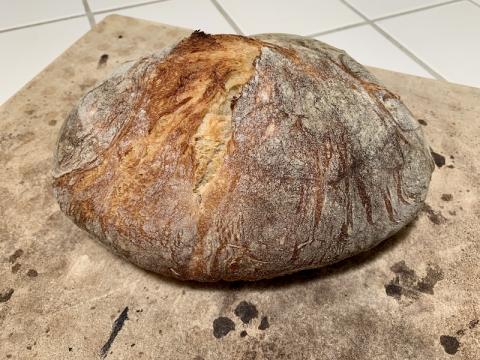
Pugliese Capriccioso revisited

I first posted a formula for a naturally leavened pugliese bread 11 years ago. I fiddled with the formula and procedure a bit over several years, but I haven’t made this bread in about 6 years. Today’s version is different from some of the ones I have made before in a couple respects: First, I use an all-white flour biga rather than a mixed grain liquid levain. And, second, I hand mixed rather than using a stand mixer.
The dough had excellent gluten development. It was silky smooth yet quite loose and extensible. It spread a bit when transferred to the baking stone but had very good oven spring.
Total Dough | Wt. (g) | Baker’s % |
All Purpose Flour | 442 | 78 |
Fine Durum Flour | 125 | 22 |
Water | 433 | 76 |
Salt | 10 | 1.8 |
Total | 1010 | 177.8 |
Biga Naturalle | Wt. (g) | Baker’s % |
All Purpose Flour | 48 | 100 |
Water | 24 | 50 |
Ripe stiff levain (50% hydration) | 29 | 60 |
Total | 101 | 210 |
1. Dissolve the levain in the water.
2. Mix in the flour to hydrate well.
3. Cover and ferment at 78ºF until double in volume.
4. Refrigerate overnight
Final Dough | Wt. (g) |
All Purpose Flour | 375 |
Fine Durum Flour | 125 |
Water | 400 |
Salt | 10 |
Biga | 100 |
Total | 1010 |
Procedure
- Take the biga out of the refrigerator and warm to room temperature.
- Mix the water and flours to a shaggy mass, cover and autolyse for 60 minutes. (Note that Durum flour absorbs water more slowly than AP flour.)
- Sprinkle the salt over the dough, then add the biga in chunks. Mix the salt and biga into the dough using the pinch and fold method.
- Transfer the dough to a lightly oiled container large enough to accommodate a doubling in volume. Cover the container.
- Ferment at 80ºF until the dough is almost doubled with stretch and folds at 30 and 60 minutes. (about 4-5 hours)
- Transfer the dough to a floured board and pre-shape as a ball. Cover and let rest for 10-20 minutes.
- Shape as a boule and transfer to a floured banneton, seam side down. Place in a food safe plastic bag and proof. (About 2 hours.)
- 45-60 minutes before baking, preheat the oven to 500ºF with a baking stone or steel on a middle rack and your steaming apparatus ready to use.
- Turn the oven temperature down to 460ºF. Transfer the loaf to the stone (seam side up) and steam the oven.
- After 15 minutes, remove the steam source. Bake for another 20-30 minutes or until the loaf is fully baked. The crust should be nicely colored. The internal temperature should be at least 205ºF. The loaf should sound hollow when thumped on the bottom.
- Optionally, leave the loaf on the baking stone with oven turned off and the door ajar to dry the crust further.
- Transfer the loaf to a cooling rack. Cool completely before slicing.


The crust was chewy. The crumb was cool, moist and soft-chewy. The flavor was not sour in the least but just a good white bread. I did not detect any distinct flavor contribution of the durum flour. Nice bread, but I do prefer one with 30-40% whole grain flour these days. YMMV.
Happy baking!
David


Comments
Good bake David. Are chewy crust and crumb desirable for your taste? I am the opposite as I prefer my breads to have a thin crust that would crack easily and a light crumb that would melt upon the first bite.
In general, I prefer a crunchy crust. A thin, crackly crust like that of a typical baguette sur poolish is very difficult to achieve with a home oven, in my experience. It's even harder with sourdough baking.
David
Looks delicious David. You mention preferring 30-40% whole grain lately have you tried this same recipe using whole spelt or whole durum?
Benny
I don't have durum berries at the moment. Anyway, what I made is what I intended to make. It's just not my favorite type of bread.
David
Great looking loaf and crumb! I haven't worked much with stiff bigas but this recipe might inspire me to do so. I love the natural 'score' on the bread too.